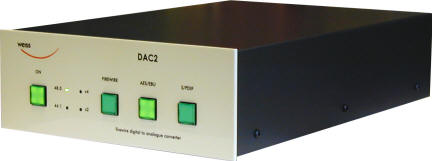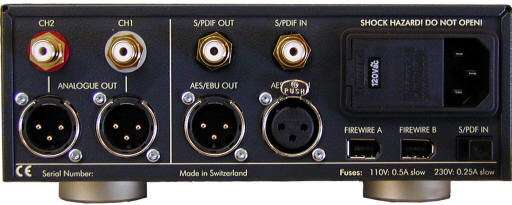The Weiss DAC2 benefits from the experience and technology of the well-received Minerva digital-to-analog converter (DAC). The DAC2 is distributed in the US by Vintage King Audio, a well know dealer of pro audio equipment. At a list price of $2995, it has fewer features, but the same audio and digital circuits, as the $5000 Minerva which the DAC2 has replaced.
The DAC2 has two analog balanced outputs on XLR connectors and a pair of analog unbalanced outputs on RCA connectors. It offers one S/PDIF digital input and one S/PDIF digital output on RCA connectors, and one S/PDIF input on Toslink optical. There is an AES/EBU input and an output on XLRs. Also included on the well-laid out rear panel are two FireWire 400 connectors. Auditioning for this review used the balanced analog outputs and both the FireWire and S/PDIF RCA inputs.

The front panel sports nice lighted buttons for power on, and input selection for FireWire, AES/EBU and S/PDIF. Small LED indicators display the current sampling rate of 44.1 or 48.0kHz with adjacent multiplier indicators for x4 and x2. Sampling rates of 44.1, 48, 88.2, 96, 176.4 and 196kHz are displayed with only four LEDs. The compact – and almost half empty – chassis will fit easily in almost any equipment rack.
The supplied software can change some settings and provides some control over playback sampling rate. Bit depth is fixed at 24. The manual is inadequate for those without experience with this type of device. For example, under the software Sampling Rate section, it reads “The sampling rate of the device when internally clocked.” The software is not too complex, however, and one soon figures out how to set the device for normal use. Two of the input selection buttons can be configured for volume up/down which could allow the DAC2 to control a power amplifier without the need of a separate preamplifier. A computer is not required and you could connect the DAC2 between your CD player/transport and preamplifier using only the front panel buttons to change the settings.
The software is very stable and worked perfectly with Windows 7, retaining the last settings without reverting to the original defaults. It also perfectly accepts changes from the playback software, in this case, JRiver. Changing the sampling rate in JRiver to 176.4 (which I use to upsample 44.1kHz WAV files created from CDs) or 192kHz for my LP recordings instantly changed the playback rate in the DAC2 to match, and the front panel indicator lights changed appropriately.
The DAC2 is unusually sensitive to power cords, even though it is plugged into a PS Audio AV Power Center 5000 power line conditioner which greatly limits the variability of the sound of power cords with most components. A poor match in power cords can make the sound bright, forward, and harsh and compress the sound stage. I used the excellent Audience PowerChord ‘e’ for this review.
The comparison DAC was the Prism Orpheus Digital Interface, a digital “Swiss Army Knife” that can be used as a DAC, ADC (analog-to-digital converter), upsampler, preamplifier, phono preamplifier, and a few other uses. The Orpheus has maintained its position as my reference digital component for over a year and has easily bested the sound of a Benchmark DAC1 and Apogee Duet, Mini-DAC, and Rosetta 200. I have not reviewed a DAC since the Orpheus earned reference status because the sound of the Orpheus leaves me wanting for only very minor, if any, improvements. However, the Weiss DAC2 is far easier to set up and use, at least initially, than the designed-for-recording-studios Prism.
The Weiss DAC2 immediately impresses with its outstanding bass presentation that provides a solid foundation for all genres of music. The bass is powerful and reminds me of one of the few reasons that we liked early digital sound from CDs. The bass is also tuneful with great pitch definition and low level resolution. The dynamic impact is the bass is also excellent. If you are looking for a DAC which can offer that “punch in the gut” sensation, the DAC2’s bass character will never disappoint you.
There is a crispness or thinness in the upper frequencies which is consistently noticeable. Since this character is in the upper frequencies but mostly absent in the midrange, it creates a discontinuity that interferes with the natural sound of female vocals, as their upper frequency harmonics have a different character than the lower frequency fundamental and first harmonic sounds. There is also a sense of congestion in the 400-800 Hz range which is almost felt rather than heard as an extra acoustic pressure in this region. Since this is in the (upper) midrange – remember that middle C is at 262 Hz – it is an important artifact.
The size of the acoustic sound stage is nicely presented. It is not quite as wide as the stage heard with the Orpheus, but the depth is similar. The excellent bass of the DAC2 provides a strong feeling of the size of the recording venue, and an open treble helps to give the listener a feeling of openness. The high frequency presentation of the DAC2 is very well done, but not as soaring and light and airy as the Orpheus.
The FireWire connection offers sound quality that is far superior to S/PDIF. This is easily heard on either converter at any sampling rate. The pros have been using FireWire connections for years and if you want the best sound from an outboard DAC, you should use FireWire, too. An excellent TI-chipset FireWire PC card is about $30. A good coax S/PDIF PC card can cost well over $300.

I rip CDs to my music computer at their native 16 bit/44.1 kHz quality after finding that the best sound is realized when upsampling on playback, not during recording. This practice also helps keep the file sizes on my hard drives to a minimum. I find that CD playback is best when the files are upsampled to 176.4 kHz, a 4x upsampling. As I have written in other reviews, it seems to be best to use whole number upsampling rates. So you would upsample 44.1 kHz to 88.2 or 176.4 kHz, and not to 96 or 192 kHz. The sound of CDs through the DAC2 at 44.1 kHz is very similar to the sound at 176.4 kHz, although the higher sampling (or “re-sampling”) rate adds a bit more richness in the upper frequencies.
Using 24 bit 176.4kHz playback of CD-sourced WAV files, the Orpheus has a bit more energy in the bass. However, in the lowest bass, the Weiss has a very small bit better resolution. On “Beachcombing” by Mark Knopfler and EmmyLou Harris, the Weiss DAC2 slightly blends the two voices together and there is not the easy clarity of these two experienced artists as is heard from the Prism. Similarly, the Prism DAC offers a far less digital, far more analog sound, smoother and richer and flowing, than the Weiss. This is not a “golden ears only” difference as it takes just a few minutes to zero in on this character of the Weiss. Even though I used 24/192 recordings from LPs for the majority of the critical evaluations, the digital fingerprint of the Weiss was consistent. For $1500 more, the Prism is the superior sounding DAC and easily worth the up charge.
Downsampling 24/192 WAV files on the Orpheus to 24/44.1 sounded similar to native 24/192 playback on the Weiss. While the Orpheus was still a bit warmer and smoother at the lower sampling rate, the differences were much smaller than at 24/192 where the Prism’s superiority was consistent and obvious, and consistently obvious. There was always that thinness and slight grain in the Weiss’ upper frequency presentation that reminded me that I was listening to hardware and which interfered with becoming absorbed by the musical performance. As much as I found this distracting, it is important to mention that the YG Acoustics Kipod (pronounced KEY-pode) Main Modules speakers (which are the Kipod Studios without the bass modules) are not kind to anything upstream that is not absolutely free from edge or grain or consistent from octave to octave in overall tonal balance. The Kipods are a great reviewing tool, and exceptional for providing hugely enjoyable listening experiences, but they brook no deficiencies in the input signal. I suggest that the DAC2 would gain in overall musicality with a “kinder, gentler” speaker, such as the Spendor S5e which has significantly less resolution in the upper frequencies than the speakers used for this review.
Often during my audition of the Weiss DAC2 I was reminded of the sound of the Benchmark DAC1. Neither qualifies as a reference level component, consistently providing involving listening experiences and passing 10 Audio’s Zen Test. In a system with complementary components, the Weiss DAC2 could offer enjoyable sound.
Overall Rating: 7.5 LPs
Link to distributor’s Web site: Vintage King Audio
My thanks to Ryan McGuire at Vintage King Audio. This review would not have been possible without Ryan’s kind assistance.
